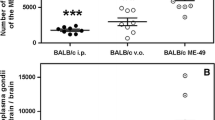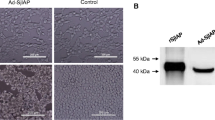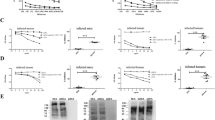Abstract
Passive transfer of immunity using a mouse monoclonal IgE antibody againstSchistosoma japonicum was found to be enhanced by heterologous helminth infections. BALB/c mice were infected withToxocara canis orNippostrongylus brasiliensis so as to induce eosinophilia prior to a challenge infection withS. japonicum. Recovery of adult schisotomes decreased in a group of mice that had been infected withT. canis and challenged with cercariae at the cutaneous site of sensitization with the IgE antibody as compared with that in mice that had been similarly treated with normal serum in the absence ofT. canis infection. Histological examinations revealed a close association of polymorphonuclear cells, including eosinophils, with damaged schistosomula in the skin ofT. canis-infected mice that had received the IgE antibody. An enhancement in worm reduction was also observed in mice harboring either of both nematodes when the monoclonal antibody had been injected intraperitoneally during the phase of migration of schistosomula from the skin to the lungs. In vitro studies on macrophage-mediated damage to schistosomula suggested that the enhancement in worm reduction was at least partly due to the activation of macrophages induced by the heterologous infections.
Similar content being viewed by others
References
Böttcher I, Ulrich M, Hirayama N, Ovary Z (1980) Production of monoclonal mouse IgE antibodies with DNP specificity by hybrid cell lines. Int Arch Allergy Appl Immunol 61:248–250
Capron A, Dessaint JP, Capron M, Bazin H (1975) Specific IgE antibodies in immune adherence of normal macrophages toSchistosoma mansoni schistosomules. Nature 253:474–475
Capron A, Capron MJ, Dessaint JP (1980) Immunology 80. Progress in immunology, vol IV. Academic Press, New York
Christensen NØ, Nansen P, Fagbemi BO, Monrad J (1987) Heterologous antagonistic and synergistic interactions between helminths and between helminths and protozoans in concurrent experimental infection of mammalian hosts. Parasitol Res 73:387–410
Crandall RB, Crandall CA, Hunter GW, Arean VM (1966) Studies on cross-resistance in schistosome andAscaris suum infections of mice. Ann Trop Med Parasitol 60:70–77
Damonneville M, Auriault C, Thorel T, Verwaerde C, Pierce A, Strecker G, Capron A (1986) Induction of a protective immune IgE response in rats by injection of defined antigens of schistosomulum-released products: immunochemical properties of the target antigens. Int Arch Allergy Appl Immunol 79:320–328
Dean DA (1983) A reviewSchistosoma and related genera: acquired resistance in mice. Exp Parasitol 55:1–104
Duvall RH, DeWitt WB (1967) An improved perfusion technique for recovering adult schistosomes from laboratory animals. Am J Trop Med Hyg 16:483–486
Hagan P, Blumenthal UJ, Dunn D, Simpson AJG, Wilkins HA (1991) Human IgE, IgG4 and resistance to reinfection withSchistosoma haematobium. Nature 349:243–245
Horowitz S, Smolarsky M, Arnon R (1982) Protection againstSchistosoma mansoni achieved by immunization with sonicated parasite. Eur J Immunol 12:327–332
Hunter GW, Wallis MV, Crandall RB (1967) Studies on schistosomiasis: XXII. Cross resistance inSchistosomamansoni andNippostrongylus brasiliensis infections in albino mice. Exp Parasitol 21:9–15
James SL, Pearee EJ (1988) The influence of adjuvant on induction of protective immunity by a non-living vaccine against schistosomiasis. J Immunol 140:2753–2759
James SL, Skamene E, Meltzer MS (1983) Macrophages as effector cells of protective immunity in murine schistosomiasis. V. Variation in macrophage schistosomicidal and tumoricidal activities among mouse strains and correlation with resistance to reinfection. J Immunol 131:948–953
Kamiya H, Smithers SR, McLaren DJ (1987)Schistosoma mansoni: autoradiographic tracking studies of isotopically labeled challenge parasites in naive and vaccinated CBA/Ca mice. Parasite Immunol 9:515–529
Kigoni EP, Elsas PPX, Lenzi HL, Dessein AJ (1986) IgE antibody and resistance to infection. II. Effect of IgE suppression on the early and late skin reaction and resistance of rats toSchistosoma mansoni infection. Eur J Immunol 16:589–595
Kojima S, Ovary Z (1975) Effect ofNippostrongylus brasiliensis infections on anti-hapten IgE antibody response in the mouse. I. Induction of carrier specific helper cells. Cell Immunol 15:274–286
Kojima S, Yamamoto N, Kanazawa T, Ovary Z (1985) Monoclonal IgE-dependent eosinophil cytotoxicity to haptenated schistosomula ofSchistosoma japonicum: enhancement of the cytotoxicity and expression of Fc receptors for IgE byNippostrongylus brasiliensis infection. J Immunol 134:2719–2722
Kojima S, Niimura M, Kanazawa T (1987) Production and properties of a mouse monoclonal IgE antibody toSchistosoma japonicum. J Immunol 139:2044–2049
Kojima S, Kanazawa T, Kobayashi M, Niimura M, Hata H, Orido Y, Tokita K, Konno K (1988) Epidemiologic studies on schistosomiasis japonica in a newly found habitat ofOncomelania snails in Japan. Am J Trop Med Hyg 38:92–96
McLaren DJ, Pearce EJ, Smithers SR (1985) Site potential for challenge attrition in mice, rats and guinea pigs vaccinated with irradiated cercariae ofSchistosoma mansonl. Parasite Immunol 7:29–44
McLaren DJ, Strath M, Smithers SR (1987)Schistosoma mansoni: evidence that immunity in vaccinated and chronically infected CBA/Ca mice is sensitive to treatment with a monoclonal antibody that depletes cutaneous effector cells. Parasite Immunol 9:667–682
Ogilvie BM (1964) Reagin-like antibodies in animals immune to helminth parasites. Nature 204:91–92
Ogilvie BM, Smithers SR, Terry RJ (1966) Reagin-like antibodies in experimental infections ofSchistosoma mansoni and the passive transfer of resistance. Nature 209:1221–1223
Oshima T (1961) Standardization of techniques for infecting mice withToxocara canis and observations on the normal migration routes of the larvae. J Parasitol 47:652–656
Ovary Z, Caiazza SS, Kojima S (1975) PCA reactions with mouse antibodies in mice and rats. Int Arch Allergy Appl Immunol 48:16–21
Sugane K, Oshima T (1980) Recovery of large numbers of eosinophils from mice infected withToxocara canis. Am J Trop Med Hyg 29:799–802
Usawatianakul W, Kamijo T, Kojima S (1982) Comparison of recovery of schistosomula ofSchistosoma japonicum from lungs of mice and rats. J Parasitol 68:783–790
Verwaerde C, Joseph M, Capron M, Pierce RJ, Damonneville M, Velge F, Auriault C, Capron A (1987) Functional properties of a rat monoclonal IgE antibody specific forSchistosoma mensoni. J Immunol 138:4441–4446
Author information
Authors and Affiliations
Rights and permissions
About this article
Cite this article
Janecharut, T., Hata, H. & Kojima, S. Effects of heterologous helminth infections on passive transfer of immunity using a mouse monoclonal IgE antibody againstSchistosoma japonicum . Parasitol Res 77, 668–674 (1991). https://doi.org/10.1007/BF00928681
Accepted:
Issue Date:
DOI: https://doi.org/10.1007/BF00928681




